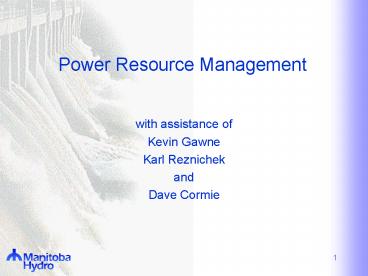Power Resource Management - PowerPoint PPT Presentation
1 / 36
Title:
Power Resource Management
Description:
Gull (630 MW) - Conawapa (1400 MW) Potential New. Generation. and HVdc. Winnipeg. Wuskwatim. Gull. Conawapa. New HVdc. 10. Variability of Hydraulic Supply ... – PowerPoint PPT presentation
Number of Views:68
Avg rating:3.0/5.0
Title: Power Resource Management
1
Power Resource Management
- with assistance of
- Kevin Gawne
- Karl Reznichek
- and
- Dave Cormie
2
Basics of Hydroelectric Generation
3
Hydroelectric Generating Station
Dam
Forebay
Spillway
Powerhouse
Flow
Tailrace
4
Cross Section of a Typical Hydro Unit
Forebay
Vertical Axis
Generator
Head (H)
Flow (Q)
Tailrace
Turbine
Efficiency (e)
Power Flow x Head x efficiency x constant
5
Introduction toManitoba Hydro System
6
Nelson and Churchill River Drainage Basins
7
System MapTotal Installed Capacity 5480 MW
Southern Indian Lake
Stephens L.
Laurie River
Limestone
Long Spruce
Kelsey
Kettle
Split L.
HVdc
More than 90 Hydraulic Based Generation
Jenpeg
Lake Winnipeg
Grand Rapids
Selkirk
Brandon
8
Interconnected Transmission System
9
Potential New Generation and HVdc
Candidate Plants - Wuskwatim (200 MW) - Gull (630
MW) - Conawapa (1400 MW)
10
Variability of Hydraulic Supply(inflows measured
as energy equivalent)
1940/1941 Drought
11
Wet Winnipeg River June 8-10, 2002 Precipitation
12
Wet
13
Wet June 2002Upper English River at Sioux
Lookout
14
Wet Spill at Pointe du Bois, 2002
15
Dry Winter 02/03 Precipitation of normal
16
Dry Lake of the Woods, 2003
17
Flow Forecasting
18
Load Forecasting
- Load is related to time of year, day of week,
hour of day, temperature, other
19
Market Forecast
20
Water Supply Manitoba Electrical Demand
WATER
SUPPLY AND DEMAND
SUPPLY
DEMAND
DEMAND
WINTER
WINTER
SUMMER
21
Manitoba and Export Demand(a typical week)
5000
4500
4000
3500
3000
2500
MW
2000
1500
1000
500
0
Monday
Tuesday
Wednesday
Thursday
Friday
Saturday
Sunday
22
Power Resource Management
23
Power Resource Management
- Manage Manitoba Hydros system of reservoirs,
hydro stations, thermal stations, and tielines in
the most economic and secure manner possible - Meet or exceed regulatory requirements
- Consider environment and waterway users
24
Power Resource Management
DEMAND
SUPPLY
Uncertainty Licences Social and Environmental
- domestic load - exports - outages - losses
- inflows, storage, coal, gas - imports - plant
capability
25
Decisions
- Hydraulic stations (generate or spill?)
- Thermal stations (generate?)
- Reservoirs (store or release?)
- Energy (buy or sell?)
26
Uncertain Aspects
- Inflows into reservoirs
- Manitoba load
- Ice effects on river hydraulics
- Export/import market prices
- Thermal fuel costs
27
Key Resource Management Decision -Lake Winnipeg
Outflow
28
Decision Considerations
- Multi-stakeholder
- e.g. Lake of the Woods
- Multi-jurisdictional
- Saskatchewan R. (AB, SK, MB)
- Winnipeg R. (USA, ON, MB)
- Environment
- Transportation
- Recreation
- Addressed through
- Boards, Licences, Agreements, Programs,
Facilities, Operating Guidelines
29
System Model
30
System Model
- Decision variables
- reservoir storage (STt),
- turbine release (Rt),
- spill (St)
- produced energy (HEs,t),
- imported energy (IEs,t), and
- exported energy (EEs,t).
31
System Model
- Objective function
HCs,t - the hydro energy production cost EBs,t
- the export energy benefit ICs,t - the import
energy cost SCt - the cost of spilling water
and BT - the benefit from saving the water for
future production.
32
System Model
- Nonlinear hydro production function
- Linearized by assuming a constant value for the
head (H) and efficiency (e). - Iterative Linear Programming optimization
33
System Model
- Other constraints
- Flow continuity
- Tieline load
- Supply and demand
34
System Model
- Minimum storage
- Maximum storage
- Hydro energy relation to release
35
System Model
- Linear Programming Optimization
- 100s of decision variables
- 1,000s of constraints
- 1,000,000s of dollars benefits for the utility
and residents of Manitoba - Optimal use of power resource
- Taking advantage of the system structure
- Taking advantage of energy market
36
(No Transcript)































